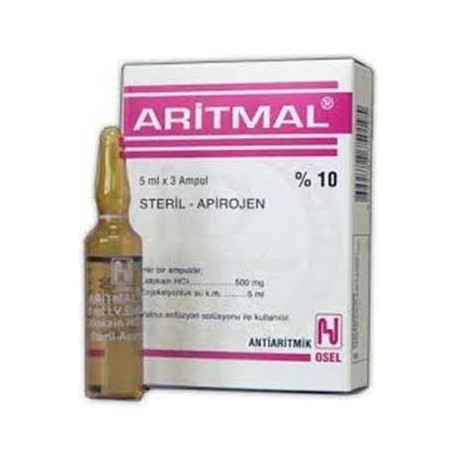 View larger
View larger Aritmal (Lidocaine) 100 Mg 5 ML 5 Vial
ART3374
New product
BUY MORE PAY LESS
| Quantity | Discount | |
|---|---|---|
| 2 | 5% | |
| 3 | 10% | |
| 4 | 15% | |
| 5 | 20% |
Volume discounts
| Quantity | Discount | You Save |
|---|---|---|
| 2 | 5% | Up to $3.20 |
| 3 | 10% | Up to $9.60 |
| 4 | 15% | Up to $19.20 |
| 5 | 20% | Up to $32.00 |
More info
4. CLINICAL FEATURES
4.1. Therapeutic indications
• In ventricular arrhythmias (extrasystoles and tachycardias)
• After acute myocardial infarction
• In arrhythmias that may occur due to myocardial damage during heart surgeries
• In diagnostic interventions such as cardiac catheterization and angiocardiography,
It is also used for infiltration anesthesia, peripheral and sympathetic nerve blockade, epidural anesthesia.
4.2. Posology and method of administration
Posology / frequency and duration of administration:
In the treatment of cardiac arrhythmias:
50-100 mg i.v. at an average of 25-50 mg per minute. loading dose is given. Alternatively, it can be given as 1-1.5 mg/kg. If the desired response is not obtained with the loading dose, a second injection can be made 5 minutes after the end of the first administration. More than 200-300 mg should not be administered in 1 hour.
Lower bolus doses may be required in elderly patients or in congestive heart failure or cardiogenic shock.
For administration as an infusion, ARITMAL is added to a 0.2% or 0.4% solution into saline or 5% glucose solution. 20-50 micrograms/kg/minute for adults (1-4 mg/minute for an average 70 kg adult). This infusion remains stable for 24 hours. It is generally unnecessary to continue infusion therapy for more than 24 hours. If maintenance therapy is essential, an oral antiarrhythmic agent will be appropriate.
Patients with congestive heart failure or liver disease should be given a slower infusion; No dose modification is required in patients with renal insufficiency. If arrhythmia occurs during continuous infusion, a small bolus dose may be administered to rapidly increase the plasma concentration of the drug; at the same time, the infusion rate is increased. The infusion should be discontinued when the patient's cardiac rhythm stabilizes or any signs of toxicity appear.
Continuous ECG monitoring is recommended during treatment with lidocaine; however, if this is not possible and a ventricular arrhythmia is suspected, in the absence of bradycardia, i.m. A single dose can be administered. For intramuscular administration, the deltoid muscle should be preferred.
Lidocaine i.m. The dose is 300 mg or approximately 4.3 mg/kg for a 70 kg adult. A 10% solution should be used for intramuscular injection. If necessary, a second dose can be administered 60-90 minutes after the first injection. If maintenance therapy is necessary, i.v. infusion or oral administration is preferred.
5. PHARMACOLOGICAL PROPERTIES
5.1. Pharmacodynamic properties
Pharmacotherapeutic group: Antiarrhythmics (class IB)
ATC Code: C01BB01
Lidocaine is an amide type local anesthetic. It is used to provide local anesthesia in many parts of the body and shows its effect by inhibiting the ionic backflow necessary for the initiation and transmission of impulses and stabilizing the neural membrane. Lidocaine has important effects on the central nervous system and cardiovascular system, in addition to the conduction blockade it causes in the nerve axon in the peripheral nervous system. After absorption, lidocaine can cause CNS stimulation and subsequent depression of the cardiovascular system, first acting on the myocardium where it can reduce electrical excitability, conduction rate and force of contraction.
5.2. Pharmacokinetic properties
General features
Absorbation:
Lidocaine i.v. After bolus administration, its effect begins within 45-90 seconds and lasts for 10 to 20 minutes. Continuous infusion of lidocaine (1-4 mg/min) is mandatory for the continuation of the antiarrhythmic effect. Lidocaine i.v. It has full bioavailability in applications. NS. In applications, it reaches the therapeutic serum concentration in 5-15 minutes and this effect lasts for 2 hours.
In intradermal applications, the effect starts within 1-3 minutes and decreases within the next 10 minutes. In ophthalmic use, the onset of action is between 20 seconds and 5 minutes (usually 40 seconds), and the duration of action is between 5 and 30 minutes (usually 15 minutes).
Distribution:
The binding rate of lidocaine to protein (alpha acid glycoprotein) is approximately 60% - 80%, depending on drug concentration. The volume of distribution (Vd) is 1.1 - 2.1 L/kg. This rate decreases in heart failure and liver disease. Lidocaine crosses the blood-brain and placental barriers by passive diffusion. The therapeutic serum concentration is 1.5-6 micrograms/ml. Generally, it is toxic if the serum level is higher than 6-10 micrograms/ml.
Bivotransformation:
90% of lidocaine is metabolized in the liver.
Lidocaine is metabolized in the liver to glycine xylidine (GX) and monoethylglycine xylidine (MEGX). Both metabolites show antiarrhythmic and convulsant properties.
Elimination:
Lidocaine undergoes hepatic elimination at a rate of 62-81%. Lidocaine has an initial half-life of 7-30 minutes and a terminal half-life of 1.5-2 hours. The half-life may be greater than 3 hours following an infusion lasting longer than 24 hours. In infants and premature infants, the terminal half-life is 3.2 hours.

